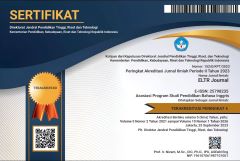STUDENTS PERCEPTION ON THE TEACHER NONVERBAL COMMUNICATION AT THE SEVENTH GRADE STUDENTS OF MTSS NAGARI BINJAI
Abstrak terlihat: 398 / PDF terunduh: 328DOI:
https://doi.org/10.37147/eltr.v5i1.103Abstract
ABSTRACT
The research was due to several problems found in the field: the teacher did not usually used nonverbal communication in English classroom. It is indicated by the English teacher when the researcher did the preliminary research when teaching learning process in this class. It is indicated when the teacher try to silent to make the students pay attention but the fact some of students still make noise and not pay attention to the teacher in this class.
The result of the research: first students perception on teacher’s gesture with 34,09% in rating quality of good. Second, students perception on teacher’s facial expression with 36,4% in rating quality of good. Third, students perception on teacher’s eye contact with 27,7% in rating quality of moderate. Fourth, students perception on teacher’s pitch with 18,45% in rating quality of poor. Fifth, students perception on teacher’s rate with 36,9% in rating quality of good. Sixth, students perception on teacher’s pause with 36,4% in rating quality of good. Seventh, students perception on the teacher’s friendship and warmth with 31,85% in rating quality of good.
Downloads
References
Adler, R. B., & Russell, F. P. (2012). Looking out looking in (14th ed.). Boston: Wadsworth Cengage Learning.
Behjat, F., Samaneh, B., & Ali, A. K. (2014). An investigation of students’ attitudes on teachers’ nonverbal interaction in Iranian EFL classrooms. International Journal of Language and Linguistic, 2(6-1).
Budyattna, M. (2011). Teori komunikasi antar pribadi. Jakarta: Kencana Prenada Media Group.
Bunglowala, A., & Aaquil. (2015). Nonverbal communication: An integral part of teaching learning process. Special Issue, 1st International Conference on Advent Trends in Engineering Science and Technology. Bunglowala. E-ISSN: 2321-9637.
Cahya, V. E., & Prabandari, C. S. (2016). Students’ perception on pre-reading activities in basic reading II class of the english language education study program of Sanata Dharma University. LLT Journal, 18(2).
Charli, H., & Hayati, S. (2019). Furnishing English students’ proficiency for being public speaker to multilingual society at educational major. Procedings of the Fourth International Seminar on English Language and Teaching (ISELT-4).
Creswell, J.W. (2009). Educational research planning, conducting and evaluating quantitative and qualitative research.Merriil Prentice, Hall.
Irwandi. (2017). Integrating intercultural communication competence in English literature teaching: The application of reading novel. FKIP UMSB, (2)18.
Irwandi. (2017). Integrating intercultural communication competence in teaching oral communication skill. Proceedings of the Fifth International seminar on English Language and Teaching (ISELT-5).
Irwandi. (2018). Building teachers’intercultural communication competence in the digital era. The 3th International Conference on Education.
Margono. (2007). Metodologi penelitian pendidikan, komponen MKDK. Jakarta: Rineka Cipta.
Morissan. (2014). Teori komunikasi individu hingga massa. Jakarta: Kencana Perdana Madia Group.
Mulyana, D. (2012). Cultures and communication. Bandung: PT Remaja Rosdakarya.
Nurudin. (2017). Ilmu komunikasi ilmiah dan populer. Depok: PT Rajagrafindo Persada.
Pami, H. P. (2019). Integrating divine values in intercultural communication class. Fuaduna: Jurnal Kajian Keagamaan dan Kemasyarakatan, 3(1).
Putri, Y. M. (2017). Student’s perception on teacher’s communication style on student’s motivation in learning English. STKIP PGRI Sumatera Barat TELL-US Journal, 3(2).
Samovar, L. A. (2017). Communication between cultures. Boston: WadsWorth.
Sobur, A. (2016). Semiotika komunikasi. Bandung: PT Remaja Rosdakarya.
Sudijono, A. (2005). Pengantar statistik pendidikan. Jakarta: PT Raja Grafindo.
Sugiyono. (2015). Metode penlitian pendidikan pendekatan kuantitafif, kualitatif dan RND. Bandung: Alfabeta.
Sukardi. (2003). Metodologi penelitian pendidikan. Jakarta:PT Bumi Aksara.
Surkamp, C. (2014). Nonverbal communication: Why we need it in foreign language teaching. Vol.2014.
Sutiyatno, S. (2020). The effect of teachers’ verbal and nonverbal communication on students’ English achievement. Journal of Language Teaching and Research, 9(2).
Tubbs, S. L., & Sylvia, M. (2012). Human communication. Bandung: Remaja Rosdakarya.
Downloads
Published
How to Cite
Issue
Section
License
Copyright (c) 2021 riya arima, Irwandi Irwandi, Reflinda Ali

This work is licensed under a Creative Commons Attribution-ShareAlike 4.0 International License.













